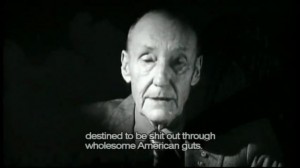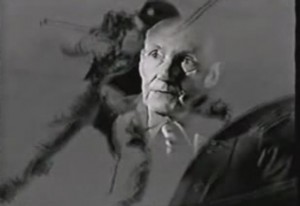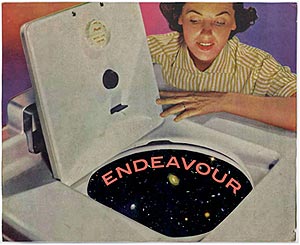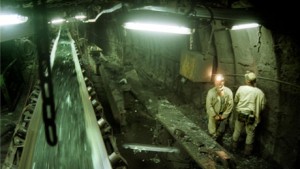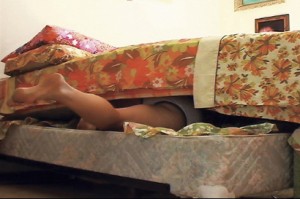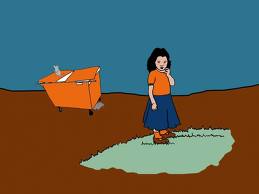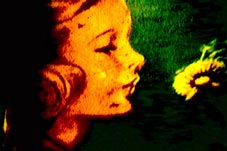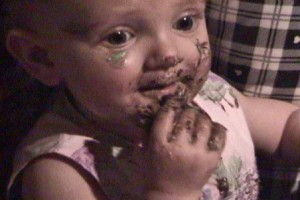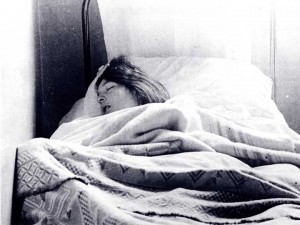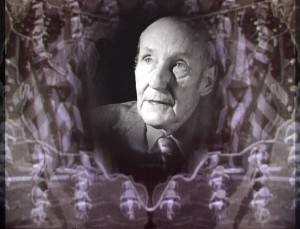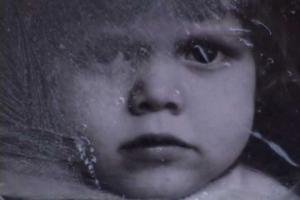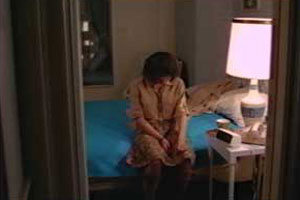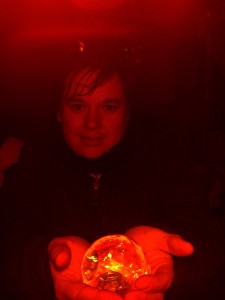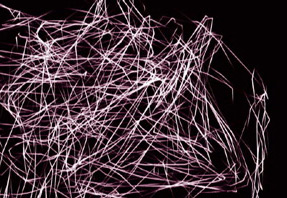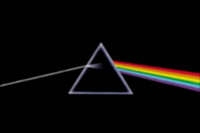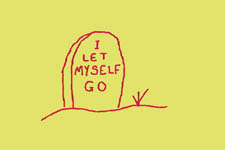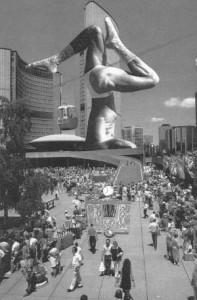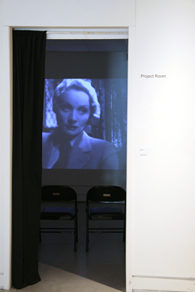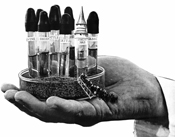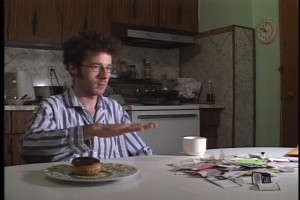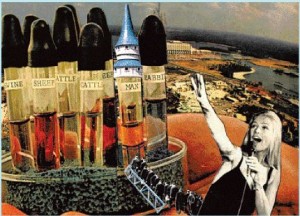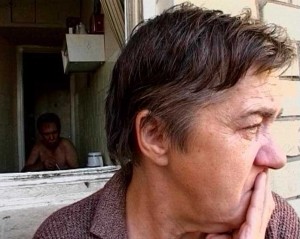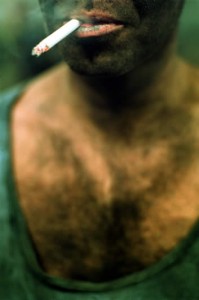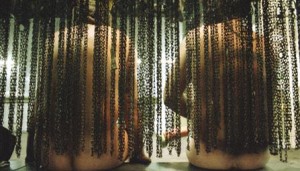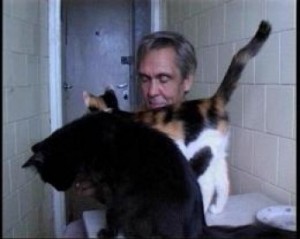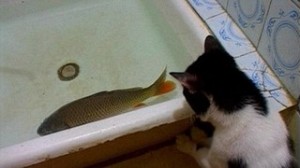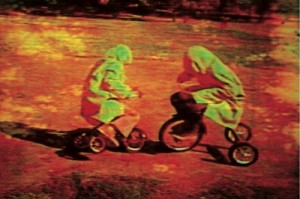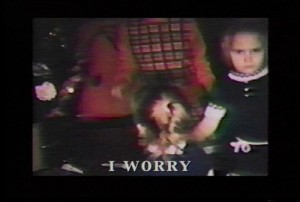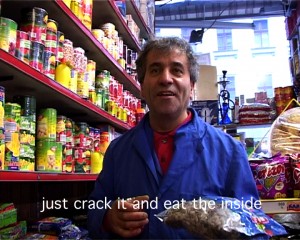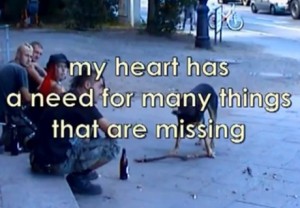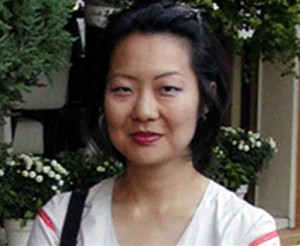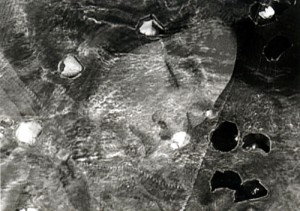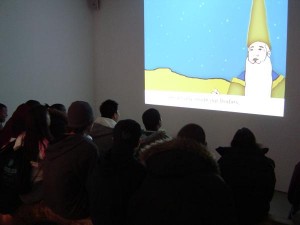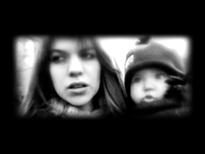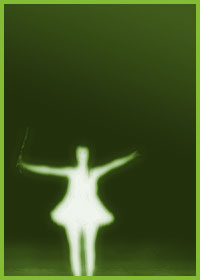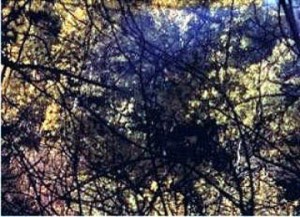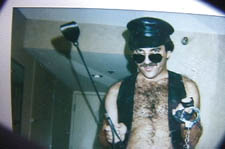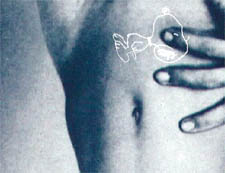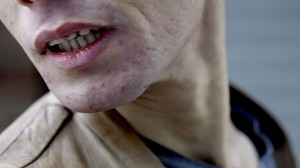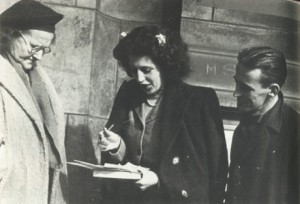
WIRED EMPIRE: THE FESTIVAL
Curated By Mike Hoolboom
For Winnipeg Cinematheque 2007
WIRED EMPIRE is a nine night festival of fringe media dreams. These programs show us the beauty and silence of the old analog world, the people we used to be, alongside digital emotions. Ready to have your operating system rebooted? Click here. Of course the global village has one mayor, but there are fault lines in Silicon Valley and artists have been jumping through the crease in order to unwrap brave new visions of what we’re going to look like, what we’re going to feel and touch like, when the pictures which surround us take root inside. These new intimacies, ripped and recoded, have been jammed with eyes grown too familiar with the glow of domestic computers. Want to catch a peak around the corner of the person you’re already becoming? Check us out already. If McLuhan was correct, that the medium was the message, then we are all part of a large social experiment in our happy, interminable interface with our computers. This series of programs hopes to underline the aesthetic changes taking place, delving into the heart of the machine to find out where we’ve been and where we’re headed.
1. Digital Dreamerzzz
Thanksgiving Prayer by Gus Van Sant 3 minutes 1999, BETA SP US
Su Naa (My Big Brother) by Helen Haig-Brown 11.5 minutes 2005, BETA SP, Canada
Supposed to by Aleesa Cohene 7 minutes 2006, BETA SP, Canada
Ready to Cope by Aleesa Cohene 7 minutes 2006, BETA SP, Canada
Ask the Insects by Steve Reinke 8 minutes 2005, BETA SP, Canada
Lockjaw by Paulette Phillips 22 minutes 1992, 16mm, Canada
2. After Disney
Genetic Admiration by Frances Leeming 23 minutes 2005, BETA SP, Canada
Draft 9 by Dani Leventhal 28 minutes 2004, BETA SP, USA
Metronome by Daniel Cockburn 10:40 minutes 2002, Beta SP, Canada
3. Welcome to the Underground
The Basement Boy Hardcore Series: Blackest Sabbath by Tasman Richardson 6 minutes 2003, BETA SP, Canada
Untertage by Jiska Rickels 25 minutes 2003, BETA SP, Holland
Diary by Oksana Buraja 25 minutes 2003, mini-DV, Lithuania
4. Girls on Fire
Nothing Happened Here by Heather Frise, 4 minutes 2006, Mini-DV, Canada
Why Always Instead of Just Sometimes by Deirdre Logue 33 minutes 2006, Canada
Death in the Garden of Paradise by Nurjahan Akhlaq 22 minutes 2004, Canada
5. Lost in Space
View from the other side of the Falls by John Price 7 minutes silent 2006, 35mm, Canada
Frequency of the Sun by Jason Boughton 10 minutes 2005, BETA SP, USA
Lost in Space by Mieke Bal and Shahram Entekhabi 17 minutes BETA SP, 2005, Holland
Sub Rosa by Helen Lee 22 minutes 2000, 35mm, Canada
Songs of Praise for the Heart Beyond Cure by Emily Vey Duke and Cooper Battersby 14.5 minutes 2006, BETA SP, Canada
6. Genius at Work
Minima Moralia by Robert Lee 85 minutes 2005, BETA SP, Canada
7. Lost Beauty
Babies in the Sun by Gariné Torossian, 5 minutes 2001, 16mm, Canada
The White She-Camel by Xavier Christiaens 52 minutes 2006, BETA SP, Belgium
8. Amerika on Life Support
Penumbra by Nathaniel Dorsky 22 minutes silent 2004, 16mm, USA
Anthology of American Folk Song by Steve Reinke 29 minutes 2004, BETA SP, Canada
9. Watchers, Peepers, Gamers
What I’m Looking For by Shelly Silver 15 minutes 2004, US
How Little We Know Of Our Neighbours by Rebecca Baron 50 minutes 2005, Beta SP, USA
FILM SELECTION
1. Digital Dreamerzzz
Thanksgiving Prayer by Gus Van Sant 3 minutes 1999, BETA SP, US
Su Naa (My Big Brother) by Helen Haig-Brown 11.5 minutes 2005, BETA SP, Canada
Supposed to by Aleesa Cohene 7 minutes 2006, BETA SP, Canada
Ready to Cope by Aleesa Cohene 7 minutes 2006, BETA SP, Canada
Ask the Insects by Steve Reinke 8 minutes 2005, BETA SP, Canada
Lockjaw by Paulette Phillips 22 minutes 1992, 16mm, Canada
Thanksgiving Prayer by Gus Van Sant 3 minutes 1999, BETA SP, US
Imagine you come home for Thanksgiving and just before chowing down, your father, who has morphed into William Burroughs, says a little prayer. “Thanks for the wild turkey and the passenger pigeons, destined to be shit out through wholesome American guts.” This video poem, set to an acerbically hysterical reading by Burroughs, features a non-stop montage of American moments where the quest for freedom shows its real toll. If God is in the details, that leaves devils like Van Sant chasing the big picture.
Su Naa (My Big Brother) by Helen Haig-Brown 11.5 minutes 2005, BETA SP, Canada
Derrida said it and now he’s dead too: when something is missing language speaks. The picture enters only too late, trying to cover the wound, to mark the place, the occasion, the words that might have, should have, the touch we didn’t, the face that isn’t any longer. Beginning in a howl of outrage, this elegantly drafted videopoem runs up all of her feelings into the light, she makes it beautiful because that is a shield too, it’s the way back into a pain doesn’t stop eating her. But she uses beauty as a way to get closer, the digital beauty of the edit machine, the time lapse camera, the pump action beer cans blown away, the shifting shadows. The rhythm of the edits brings up right up into the present because that’s where she’s already waiting for us. Not nostalgia, not the good old days, but a memory carved out of the present, like a scar.
Supposed To by Aleesa Cohene 7 minutes 2006, BETA SP, Canada
Help me and I’ll kick you in the ass. It’s just my way of saying thanks for everything, thanks for being you. Every top needs a bottom, every dog has its day. Look up and you’ll find a picture there already waiting. It’s all been done before, even your pain has arrived second hand. Keep barking.
In this succinctly edited video, found footage wunderkind Aleesa Cohene dishes the small gesture-a step towards a door, glasses adjusted, a file card flip-to show us an ordinary person (is that me?) in an ordinary crisis. The impossible dream is getting out of bed in the morning. The impossible mission is making it through a day of work. This video is all about work (Is it working? Are you working?), where the body is trained to fit a world of machines, scrubbing someone else’s floor, answering someone else’s phone.
Coffee is made, the toaster drops, a woman keeps vacuuming. The end of the world is coming but this carpet, my carpet, will be clean. A suite of mirrored encounters follow, through a cracked glass darkly. How many are we today? When I look close I can still see him, peeking out from my behind my better nature. A woman gets out of bed, packs and drives away. The car is the getaway vehicle, the great escape from the prison of hi, how are you? Windows break and the body is washed up on shore. Examine the fragments for clues. The phone is answered again and again. “Face up to who you are… Suspicions of destiny… Surely you must be feeling it?” “Yes I am,” she answers. Yes we are.
Ready to Cope by Aleesa Cohene 7 minutes 2006, BETA SP, Canada
I know what you’re thinking: please no, not another found footage compilation movie. Haven’t we been served that dish too many times already? And besides, the fruits of these labours are readily available in TV promos, best served cold in the mainstream vomitorium where they can vanish along with memory itself. But wait. Ready to Cope by Aleesa Cohene is one of a pair of movies she has spent the last three years working on steadfastly, slowly gathering pictures and then letting them settle inside her, until they become her own. These pictures wouldn’t “belong” to her any more if she had made them herself, somehow, her role as filmmaker involves the recasting of these pictures into moments of her own life. These small instants, grown back large inside the body, then becomes the new alphabet which she uses to write a new story, her own story. Everything is difficult, and troubled, and goes on forever, though it may appear for only a moment. Over and over again Cohene returns to the middle class home where these gestures recur, this is the sense of so many of these moments, that they are happening again, that they can’t help but happen again, that they never happened for the first time but only over and over. This sutured medley, broken and reassembled to show where the cracks are, make evident something of the strain of having to live inside this body, this house. Unbearable.
The artist writes: “ I use found footage because I feel that every experience and emotion cannot possibly be photographed. The realms of experience and emotion are infinite, yet so many of us choose familiarity and stability over risk and the unknown. I’m fascinated by how much silence and suffocation there is in each human interaction. We watch movies to feel something more than we allow ourselves to feel in our everyday lives.”
Ask the Insects by Steve Reinke 8 minutes 2005, BETA SP, Canada
Part home-made science (before it became doctrine and law), part animated video reverie, Reinke’s brief and episodic compression is an incendiary release which opens by announcing the death of the reader, of any audience capable of pulling its fragments together, or better, of dissolving into its tissues, of allowing the body to change shape, to identify, for instance, with an insect. Or a stone. It begins with the death of the reader and ends with the death of the author, and between he stops along the way to muse on rain falling up, the “useless bio-dioversity” of insects (meaning life is mostly decoration), signal deconstruction and beautiful noise, and burning books. His style is abrupt and associative, he jumps and jumps again, producing these small beautiful abysses which no one can see. He has produced something invisible to treasure, an impossible movie, which refuses to adhere to memory’s sound-byte continuums. It is waiting for a new body to store or restore it. And while it is waiting it speaks, like a lover on the phone. “ Whenever the rain falls, it knows it will rise again, and not full of dissolved impurities, but distilled to its essence, particles loose and moist, rising inexorably heavenward to join the endlessly protean cloud-cover, like a graveyard where all the stones have your name on them.”
“The last section is derived from footage I took a few summers ago. I walked the same path I used to walk to school, from kindergarten to grade eight. The school is at the top of a hill, on the right hand side. A graveyard is on the left hand side. When I went to school, there were no sidewalks on the long residential street leading to the school, but then the village is small and almost everyone is bussed in, often from quite far away. Today, there is a sidewalk on one side. When I get to the top of the hill, I pan between the schoolyard and graveyard. My father is buried there, and many relatives/ancestors, though of course, being an outpost in the new world, the European generations don’t go back very far. I wanted to make the assertion that every grave bore my name. I didn’t actually remember where my father was buried. If people die in the winter, they are not buried until the ground thaws (this is still the case today) but I think he died in early spring. At any rate, I hadn’t been to his grave since the burial and thought it was away from the road, closer to the river. But when I got to the top of the hill, the grave was right there, along with other Reinke stones, so it does kind of look like all the graves bear (bare?) my name.” (from an interview with Steve Reinke)
Lockjaw by Paulette Phillips 22 minutes 1992, 16mm, Canada
The quickest wit on the circuit weighs in with a talk marathon about love and language. This movie came out of a performance called Fear of Lying and it shows, everything here has been rubbed down to a fine shine, it’s slick as fresh snow and shot with a jeweller’s eye. Phillips is a triple threat as writer/director/actor, by turns funny, sad and what-me-worry. This is the kind of movie that hurts a long time after you’ve seen it.
2. After Disney
Genetic Admiration by Frances Leeming 23 minutes 2005, BETA SP, Canada
Draft 9 by Dani Rosenthal 28 minutes 2004, BETA SP, USA
Metronome by Daniel Cockburn 10:40 minutes 2002, Beta SP, Canada
Genetic Admiration by Frances Leeming 23 minutes 2005, BETA SP, Canada
In the late 1980s Frances galvanized the indie film world with her bravura short The Orientation Express. Using a painstaking, cut-out animation assembly method, it cheerfully tore up a logoed landscape long before Naomi Klein weighed in. Shortly after rumours circulated about a larger project, but as year after year went by one had to wonder: would it ever arrive? Here at last, after an epic gestation period of a decade and a half, it’s arrived at last, and well worth the wait. Exquisitely detailed frames deliver an amusement park with Marlene Dietrich as the roving fortune teller and Walt Disney as a pollinating bee. Insemination anyone? Miracle Whip jars offer a ready made sperm and egg blend, perfect for when you just don’t have the time. Can the third sex be far behind? Shoppers bumrush the enunciation and snap up the next available jar from an angel and then it’s time to pick the rentabody, that baby’s got to grow somewhere. Or in someone. Sarah it is! Next up: the womb as marine park, no need for dancing seals there are fetuses to thrill at. Finally the woman rejects all that, and staggers out of the funhouse. A broken thrill ride, amusing, critical, and sharp enough to cut your eyeballs, Leeming’s animated ms.terpiece is a force to be reckoned with.
“Placing the contemporary celebration of genetic inquiry within a mise-en-scene of theme parks, fairgrounds, Expos and Hollywood film stars, the film frames our response to the wonders of science through a focus on familiar forms of mass entertainment…” (“Critical Ensemble: A Cinema of Recombination” by Jackie Stacey)
Draft 9 by Dani Rosenthal 28 minutes 2004, BETA SP, USA
The weirdest half hour in the cinema I had all year, this travelogue of animal death returns to the real in a demonstration of the lost art of the camera. No, video doesn’t have to look ‘like that’; it can look like Dani’s pictures: deeply felt, scorched with light, filled with people floating skywards and camp survivors and animals (where does she find them?) recovered after canoeing topless through some urban bit of greenery. Now pull out the babies one by one, how small and imperfect they are. Cat food it turns out, it’s all cat food in the end. You and me both.
Metronome by Daniel Cockburn 10:40 2002, Beta SP, Canada
Cockburn’s heart pounding reflection on the pictures we are rapidly becoming takes apart its subject one big budget movie at a time. Winner of Media City’s prize for Best Canadian Movie, this movie cranked its director up into the year’s end best ten list and raised the bar for stolen pictures. All that five star editing and he can think too.
“A multimeter cinema junkie journeys to the depths of his cranium (and beyond!) in search of the greatest lowest common denominator of them all. Using rapid-fire voiceover and the poly-rhythms of Hollywood to provide a guided tour of preset looped imaginings, Metronome sets out to prove that it’s easier than you might think to keep the same beat all day. Enlightenment through aggravation. Predetermined stream-of-consciousness at 144 bpm.” Daniel Cockburn
3. Welcome to the Underground
The Basement Boy Hardcore Series: Blackest Sabbath by Tasman Richardson 6 minutes 2003, BETA SP, Canada
Untertage by Jiska Rickels 25 minutes 2003, BETA SP, Holland
Diary by Oksana Buraja 25 minutes 2003, mini-DV, Lithuania
The Basement Boy Hardcore Series: Blackest Sabbath by Tasman Richardson 6 minutes 2003, BETA SP, Canada
The hardest cutter on the block turns in this love mass for the working class. Yes, I’m afraid so, it really is Black Sabbath, in the good means bad old days, tripping in the few years they really had before toxic personalities and too many designer drugs turned them into television casualties. If they’d started later they could have run a number like this for the I-want-my-MTV kids. A hurricane of mouse clicks and digital stutterings, layered up fast and greasy and sexy hot, just the way we like it.
Untertage by Jiska Rickels 25 minutes 2003, BETA SP, Holland
A bone deep reflection on masculinity and darkness, on what it means to be a body. This unflinching and beautiful descent takes a radical turn in its closing moments, which is not to be missed. This is how far you have to go in order to be able to touch, as if for the first time, with feeling. This is the kind of touch that used to raise people from the dead, and cure illness in the plague years. Bear witness if you dare.
“A beautiful depiction of a day in the life of the miners in the Lohberg-Osterfeld coalmine in Germany. In little carts, the men descend into subterranean galleries. Beside an arrow on one wall someone has written “Zur Holle”: To Hell. Deeper and deeper, the camera penetrates the interior of the earth, where darkness reigns and strange sounds of people and machines are distorted into a frightening cacophony. At the end of the day the miners come back up to the daylight. There, they change and rinse the dust from their pores.” Thessaloniki Documentary Festival
Diary by Oksana Buraja 25 minutes 2003, mini-DV, Lithuania
Could it be any more intimate? Real love with a real couple, arguing, holding, touching, and failing to touch. The intimacy of anger, of bottles won and lost and raised again in defeat. You only hurt the ones you love.
“At the time of famine in Russia in 1921, Ana dreamt of her unborn granddaughter crying bitterly for help. Ana described this vision in her diary, to be one day discovered by Larisa, her 56-year-old granddaughter. The film depicts life in a post-communist country where pensions are extremely insufficient, old flats are deteriorating and despair is the daily companion of the old and poor.” Oksana Buraja
4. Girls on Fire
Nothing Happened Here by Heather Frise, 4 minutes 2006, Mini-DV, Canada
Why Always Instead of Just Sometimes by Deirdre Logue 33 minutes 2006, BETA SP, Canada
Death in the Garden of Paradise by Nurjahan Akhlaq 22 minutes 2004, BETA SP, Canada
Nothing Happened Here by Heather Frise, 2006, Mini-DV, Canada
A brief hallucinogenic short about the filmmaker’s sister Gillian. They are close, closer than even sisters have a right to be, close enough to be able to make a picture even, and to maintain the mystery and distance that every real picture requires. This is an excerpt from an ongoing work-in-progress.
Why Always Instead of Just Sometimes by Deirdre Logue 33 minutes 2006, BETA SP, Canada
A suite of episodic shorts performed by the artist (who else?), using the body as a material to produce pictures of the small wound we have become. The wound, the opening, the aperture. She produces pictures with her body the way others smear around canvas or work up mounds of clay.
Sometimes when I get up in the morning there is an arm missing, or a foot, an eye. It never lasts for long but the journey is not an easy one, from one part of the night to another. I will turn my tables back into forests. Stop trying to think more than one thought at the same time. Make an approach. It is time, past time now, to try and make an approach to the image. I will fail of course, the artist has shown me what it means to fail. She succeeds through failure. Failure is the portal, the entrance, the beginning of her work. Her videotapes, still so very young, are a cornucopia of failure. Let me count the ways. I will fail too. Falling down eight times, getting up nine. No need to worry about that any more, the marks it leaves behind are conversation pieces. Openings for strangers. For you.
Death in the Garden of Paradise by Nurjahan Akhlaq, 22 minutes 2004, BETA SP, Canada
How could she have drawn another breath after what happened? After an unimaginable family tragedy Ahklaq returns to her roots in Lahore, India, in the family compound which was known among insiders as the garden of paradise. This is where the unthinkable can’t stop happening. She returns as motion picture detective, surveying the faces and sounds and feelings that surround the garden. She walks with a stunned and rapt intensity into a world of men (women are hidden behind cloth or faraway walls). They look back at her, and she looks into their faces for clues. Was it you? Or you? Somehow the tragedy has given her the courage to look like this, to walk with her motion picture hurt and bring it up into their faces. The camera is held in her hands and she walks with it, so we can feel her body moving through space, returning to itself, drifting away and then catching itself, over and over. It wants to escape the wound of this place but over and over it jolts itself back into the present. Looking is painful and beautiful and a trial she endures with the aid of her camera. A group of children play cricket, an innocent scene right? Beautifully photographed for sure. But look again: there are only boys on this field. The only woman is behind the camera. She conjures the whole of her childhood in a small scene in the garden with falling petals and a dog, her use of words is minimal throughout, she is intent to show instead, and closes the movie with an elegy that is all the more powerful for its lack of language. Is it too much to say that out of this tragedy a filmmaker has been born?
5. Lost in Space
View from the other side of the Falls by John Price 7 minutes silent 2006, 35mm, Canada
Frequency of the Sun by Jason Boughton 10 minutes 2005, BETA SP, USA
Lost in Space by Mieke Bal and Shahram Entekhabi 17 minutes BETA SP, 2005, Holland
Sub Rosa by Helen Lee 22 minutes 2000, 35mm, Korea
Songs of Praise for the Heart Beyond Cure by Emily Vey Duke and Cooper Battersby 14.5 minutes 2006, mini-DV, Canada
View from the other side of the Falls by John Price 7 minutes silent 2006, 35mm, Canada
Shot with a small, hand-cranked 35mm camera, Price visits a tourist’s playground and returns with the mystery intact. Instead of using his camera as a shield, to protect himself from seeing, here he strips away the layers of culture and artifice and returns us, in a sublime chemical reworking, to a primal scene of witness. Those vast supernal bodies of light: they’re us!
Frequency of the Sun by Jason Boughton 10 minutes 2005, BETA SP, USA
Jason Boughton has reinvigorated the political project of the American fringe. His two deeply felt and thoughtfully constructed shorts ( A Halter of Tightly Twisted Rope (16.5 minutes 2005) and now The Frequency of the Sun ) were made post-9/11, an event which roused this once fringe filmer and programmer from a prolonged retirement from the image. Both his movies take aim at the American empire, Frequency deliberately conflating moments of pagan worship with Christian chorales (hymns to the son/sun). These sung interludes punctuate moments from an aerial mission from the first American-Iraq war, which is replayed to terrifying effect, recounted in a slowly drawling, looped discourse which emphasizes the way language can be bent to express the inexpressible, to make murder possible, even desirable. The American convoy has landed in a rural moment of a country where even grass looks like the enemy. They have come from the skies, parachuted down in order to lay waste to everything they encounter, gods created by technology. When they are met by a few villagers their reaction is murderous, even though some are only children. The reasons for their response are laid out in Boughton’s careful parsing of the recount, and his swaying landscapes and redigitized figures jumping from planes deliver a rhetorical corrective to more usual pictures of war which manage to show little, while pretending towards transparency, “live” and proximate.
“The key piece of music in Frequency is Vivaldi’s setting of ‘Piango, Gemo…‘, an anonymous poem which describes a heart so broken, the only hope for rest is that another greater pain might come to destroy the speaker completely. But all three musics are about powerlessness-the speaker describes their own total brokeness, they surrender to it with very little expectation of mercy.” (JB)
Lost in Space by Mieke Bal and Shahram Entekhabi 17 minutes BETA SP, 2005, Holland
Armed with a twenty two page resumé and a small library of books bearing her own name, one of the brightest stars in the Dutch theory firmament has reinvented herself as a media artist. Her work carefully and ethically takes up questions of displacement and migration, and shows her willingness to intervene in a direct way, using the recording instrument not as a window or bludgeon, but a tool which can be managed from both sides of the camera. She dares to risk stagings of “the Other” without voyeurism or spectacle, shorn, in short, of the usual first world, televisual documentary empathics that continue to extrude a well meaning colonialism. Bal’s project radically reissues a challenge to these documentary commonplaces by working outside the commissioned rectangle.
In Lost in Space she and co-conspirator Entekhabi unveil a panoply of speakers and places, one after another, in a kind of credit sequence. Only after the last portrait has been left behind do we hear their voices, and this displacement of sound and picture mirrors the subject of their speaking: each of these people have had a direct experience of migration, discrimination, loss and fear. But by deferring the contact high of language their statements can arrive without the visual prejudice and voyeurism that would be inevitable had we watched them “in sync.” In fact, they are more “in sync” now that they are shorn of their lip synced duty, we are more able to hear them, and they are better able to represent themselves. A bold move from one of the new and most important voices in today’s documentary landscape.
“If we had matched the faces of the speakers with their voices, you would have an incredible problem of voyeurism with some of the people… So it was indeed an ethical issue, and to have some equality among them in spite of the very different situations among them; for instance someone who is in London because they are a professor of film studies is really in a different situation than someone who is in their own home town but in a homeless shelter. The difference is important and I don’t want to erase it, but we didn’t want to individualize it. I don’t want to de-politicize it by making them all equal. They’re not equal, and that’s clear from what they say, but it’s important that they are not considered with judgment at all as individuals, in the sense of individualism, but rather as individuals in a situation.” (Mieke Bal speaking at the Images Festival, Toronto, 2006)
Sub Rosa by Helen Lee 22 minutes 2000, 35 mm, Korea
A candy coated monodrama from Seoul, this solo journey tries to find a home amidst the sprawl of small apartments and large dreams. The nameless twentysomething protagonist is off on a wander, caught between two mothers, back in the motherland, seeking a nearly wordless sexual escape, and a last rush to the ocean. Lee’s self assured direction and attention to detail ensure that we are locked into this journey, committed, caught in every glance.
“Moves beyond easy ideas about cultural identity to express an almost existential longing, capturing the senses of desire, uncertainty, desperation and salvation with a wondrous luminosity.” Laura U. Marks
Songs of Praise for the Heart Beyond Cure by Emily Vey Duke and Cooper Battersby 16 minutes 2006, Mini-DV, Canada
This dynamic duo burst onto the international vid scene with Rapt and Happy (17 minutes 1998), an episodically hip manifest that was wordsmart AND you could sing along to it. Seven years on they’re busy maintaining their own high standards with Songs of Praise. There are repeated musings on animal life as the division between a cultured city momentum is pitted against the natural order of things. In one sterling sequence the camera pans over a vast, digitally frozen (and constructed?) scene teeming with wildlife as Vey Duke croons about the miracle of the bird’s annual return. Come back to this? Whatever for? Animations rework the same divide in winningly brief philosophical expositions, the artists express a clear identification with a seed sprouted too early, struggling for life. Singing lends this tape a folktronica feel, despite the machine made reliabilities, there is something very hand crafted and just our point of view about all this. If it isn’t quite as stirring as their earlier anthemic works which dared to be more personal, even confessional, this tape nonetheless finds the pair shuddering through an eloquent winter and still singing.
“There is no such thing as self-esteem. Self-esteem as a construct is illogical and contradictory, so its frequent deployment as the lynch-pin of New Age discourse seems to me satisfyingly appropriate. I don’t trust anyone who doesn’t have frequent bouts of self-loathing. There is something truly monstrous about the self-righteous. Eating a well-balanced diet is a horrible act of aggression. Whenever I hear the word “culture” I think of bacteria mutating under an ultraviolet light and I’m happy again for a while. Within the Petri dish: unfettered egoless desire, the proliferation of new possibilities, ideas made flesh, uncaring and finally airborne. Empathy is a tool for making the cruelty more precise. Beauty is independent of taste; the sublime only works for suckers. Whenever I laugh I feel guilty.” Steve Reinke
6. Genius at Work
Minima Moralia by Robert Lee 85 minutes 2005, BETA SP, Canada
If he could reduce himself to the vanishing point, wear a cloak of invisibility, find himself unremarked and unregarded, yes he would. But with a commission and a deadline looming Canada’s resident fringe movie genius Robert Lee reworks his past two decades in movies to produce his masterpiece, an abject beauty filled with sorrowful jokes and characters and an unexpected delicacy of touch. Oh wait, you mean you haven’t heard about this movie? It should have graced every cover of the movie making kingdom but its means were too modest, its maker too retiring to speak to anyone involved in publicity. But here it is, the best movie made on no budget I’ve ever seen, with its liquid pictures melting into one another, its found footage smarts, its elliptical writings. This is what happens when you stop leaving the apartment and read library books for a living. The head grows large until it bursts into picture and song.
Impelled by the artist’s raspy whisper, and a repeated lounge refrain, the rapid fire grey and white pictures, dim with gloom and rain and nighttime and bad lighting, show us a world that has been left behind. The pictures are filled with sidelong glimpses, there is a keen attention to the edge of things, over and over the central part of the frame is dark, blurry, evacuated. These are marginal pictures, pictures which long, like their maker and handler, to disappear. Culled from forgotten moments in feature films, or shot himself, the blend makes them indistinguishable, each has been signed with an X.
“Two bags of vomit are walking down the street. One gets sentimental and begins to cry. The other asks, ‘Why are you crying?’ And the crying bag of vomit says, ‘I was brought up around here.’”
7. Lost Beauty
Babies in the Sun by Gariné Torossian, 5 minutes 2001, 16mm, Canada
The White She-Camel by Xavier Christiaens 52 minutes 2006, BETA SP, Belgium
Babies in the Sun by Gariné Torossian, 5 minutes 2001, 16mm, Canada
Shot through scrims of glass with a hazy, it’s-always-summer-time feel, Gariné takes a Sparklehorse song and makes it her own. When she hears him sing the words she looks up and finds My Book of the Farm, a cartooned child’s primer of play. While each of the pictures are still they flicker past in Gariné’s retake as if touched by the eye, melting, scratched over, rephotographed as colour fields off TV. And while the artist’s original encounters with these pictures were brisk, all jagged edges and hip hop hiccups, she’s slowed everything down, letting these fractured fairy tales take a waltz turn with Mark’s looping whispers. The lyrics are added by hand, two or three words crouched inside clouds or scribbled across horses, lending an affectless charm. Not laboured over. That’s what it looks like. One long bit of easy. Never mind the hours in between, the outtakes and mis-steps, this is love without trial or sweat. Gariné somehow manages to get her feelings all the way through the clichés and borrowed pictures, even the materials are dissolving to the touch, the song is fading, faded, gone, until there is nothing left but this feeling, heavenly feeling, exclamation point of their love.
The White She-Camel by Xavier Christiaens 52 minutes 2006, BETA SP, Belgium
Punctuated by a series of enigmatic intertitles (“How many were they on board? Impossible to know!”) this dreamy elegy for a lost Russian life is filled with slow moments of rapture. From an abandoned shipyard to a gaggle of teen rollerbladers, the strangely perfect camera work of Christiaeens offers us moments of invention again and again. Come check out why he keeps walking away with an armful of trophies at international fests, there’s simply no one else out there like him. And for all those who are forced to work with DV (who has the scratch for anything more?) you’re not going to believe it. It looks finer, more intense, more beautiful than those 35mm daydreams that wash over the big screen. With an austere and sober soundtrack, his wide angle traversal of spaces invites us to feel our looking, to weigh what it means to look so closely. Yes, let’s take a walk and look at that smashed bit of junk in the middle of the alley. Let’s wander out into the village when no one else is around, we might be the only ones left in this ghost town, with a ghost wind bearing news from far away. The empire is ending. “Summer has been extended and so has my stay.” Not simply the record of the passing of a way of life, and never stooping to nostalgia, he gets down with the dogs, watches the children’s faces, and offers us the same shattering white light that have led others to murder. He might be looking at your neighborhood, buried in snow, at your first and last thoughts, touching with tenderness. He won’t let us forget.
8. Amerika on Life Support
Penumbra by Nathaniel Dorsky 22 minutes silent 2004, 16mm, USA
Anthology of American Folk Song by Steve Reinke 29 minutes 2004, BETA SP, Canada
Penumbra by Nathaniel Dorsky 22 minutes silent 2004, 16mm, USA
Once more, with feeling: the great silent work of the west coast Bolex maestro brings home the light in this visitation of dailiness. The way her face looks when she turns, the fold of a paper next to that window, can we make cinema out of that? We must, he has, and no one again, never better. As pure as the light gets from that world, the one we’re all busy rubbing our faces into, and the other one, cast through the machine, somehow he makes it all look like heaven.
Anthology of American Folk Song by Steve Reinke 29 minutes 2004, BETA SP, Canada
News from the frontlines of empire from Canada’s most important video artist. For the past five years Reinke has been toiling away in Chicago, and here he offers a summary reflection. Anthology is a magnificent mini-opus, recalling Harry Smith’s original recordings of backwoods dissent, the drop outs, the ones who never fit, the ghost homes and circus runaways, they’re all here, video brushed into refusals of anything that might once have looked like home.
“They had been unable to believe in the existence of terrorists. After all, none of them had discovered any repressed memories of terrorist abuse. They had focused instead on the more immediate and real threat of serial killers, alien abductors and Satanic ritual abusers.” (SR)
9. Watchers
What I’m Looking For by Shelly Silver 15 minutes 2004, BETA SP, US
How Little We Know Of Our Neighbours by Rebecca Baron 50 minutes 2005, Beta SP, USA
What I’m Looking For by Shelly Silver 15 minutes 2004, BETA SP, US
A collection of photographs offer us portraits, moments excised from the flow, each one a wound. Here is a wound of a face, a young wound, only a child, staring out at something we will never see. The photographer wants to get close with her camera, to crawl into the skin of these strangers until we can feel them looking back at us. Where there is a wound there is a subject.
In What I’m Looking For Silver reinvigorates the genre of street photography offering us the pensive and confused, the delighted and merely curious, all lit up on the faces of passersby. She contacts strangers via the internet asking for anyone, anyone at all, who would like to show her something that could be photographed. A man on a bridge, a man who bares his armpit, a woman who wants to be photographed while playing pool naked, a Japanese man at the other ground zero, a London man in his briefs, and then without, they arrive one after another. “I want him to show me what he wants me to see.” An essay brief about power, desire and looking, the little death that is the photograph and the death of the author. “The brave are in front of the camera, the cowards behind it.”
How Little We Know Of Our Neighbours by Rebecca Baron 50 minutes 2005, Beta SP, USA
Baron’s incisive, award winning doc looks at the UK Mass Observation Movement. Begun in the 1930s, they would go out to pubs to see how long it took to drink a pint, what were patrons wearing, why that smile? They timed the laughter of movie audiences, and noted how many seats shared a spittoon. “The true nature of Britain’s repressed society was to be revealed through everyday objects and events.” The portable, snapshot camera was central to all this, and then a new kind of cinema, offering “direct” views of “real life.” Have they polished their shoes? Are the windows open? The colonial gaze returned with the camera to the streets of London, and while they are gone they are hardly forgotten, the average Londoner is photographed three hundred times per day. Baron looks at this looking with an even handed generosity, allowing her subjects to speak, and allowing us time to walk the streets and see how cameras are again and again raised to ward off experience. In the city I live in, anything beyond a glance is considered hostile, though several friends remarked during their pregnancies that invisibility was tough to bear. Do we want, even need, to be seen? This movie raises the hard questions in a smooth concoction of archival moments and present day encounters.
